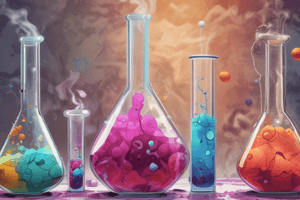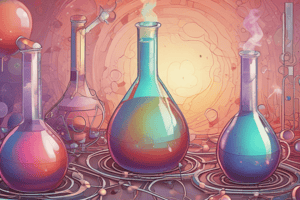Podcast
Questions and Answers
What is the primary difference between a synthesis reaction and a decomposition reaction?
What is the primary difference between a synthesis reaction and a decomposition reaction?
Synthesis reaction involves combining two or more substances to form a new substance, while decomposition reaction involves breaking down a single substance into two or more substances.
How do chemical reactions relate to everyday applications in medicine?
How do chemical reactions relate to everyday applications in medicine?
Chemical reactions are used in medicine for diagnosis, treatment, and prevention of diseases, such as in the development of new medications and diagnostic tests.
What is the primary characteristic that distinguishes a solid from a liquid?
What is the primary characteristic that distinguishes a solid from a liquid?
In a solid, particles are closely packed and have a fixed shape, whereas in a liquid, particles are close together but can move freely.
What is the purpose of sedimentation in mixture separation?
What is the purpose of sedimentation in mixture separation?
What is the physical property that is defined as the ratio of mass to volume?
What is the physical property that is defined as the ratio of mass to volume?
What is the type of chemical reaction that involves the reaction of a substance with oxygen to produce heat and light?
What is the type of chemical reaction that involves the reaction of a substance with oxygen to produce heat and light?
How do phase changes occur in matter?
How do phase changes occur in matter?
What is the purpose of chromatography in mixture separation?
What is the purpose of chromatography in mixture separation?
What is the primary difference between a homogeneous mixture and a heterogeneous mixture?
What is the primary difference between a homogeneous mixture and a heterogeneous mixture?
How do chemical reactions relate to everyday applications in energy production?
How do chemical reactions relate to everyday applications in energy production?
Flashcards are hidden until you start studying
Study Notes
Chemical Reactions
- Chemical reactions involve the transformation of one or more substances into new substances.
- Types of chemical reactions:
- Synthesis: two or more substances combine to form a new substance.
- Decomposition: a single substance breaks down into two or more substances.
- Replacement: one element replaces another in a compound.
- Combustion: a substance reacts with oxygen to produce heat and light.
- Chemical reactions are often represented by chemical equations, which show the reactants, products, and direction of the reaction.
Everyday Applications
- Matter is used in various everyday applications, including:
- Food and drink: cooking, digestion, and nutrition.
- Medicine: diagnosis, treatment, and prevention of diseases.
- Technology: construction of buildings, roads, and electronic devices.
- Energy: fossil fuels, nuclear power, and renewable energy sources.
States of Matter
- Matter can exist in four main states:
- Solid: particles are closely packed and have a fixed shape.
- Liquid: particles are close together but can move freely.
- Gas: particles are widely spaced and can move freely.
- Plasma: high-energy state where particles are ionized.
- Phase changes occur when matter changes from one state to another, such as melting (solid to liquid) or boiling (liquid to gas).
Mixture Separation
- Mixtures are composed of two or more substances that are not chemically combined.
- Methods for separating mixtures:
- Filtration: separating particles based on size.
- Sedimentation: separating particles based on density.
- Distillation: separating liquids based on boiling points.
- Chromatography: separating particles based on their interactions with a stationary phase.
Physical Properties
- Physical properties of matter include:
- Mass: a measure of the amount of matter in an object.
- Volume: a measure of the amount of space occupied by an object.
- Density: the ratio of mass to volume.
- Buoyancy: the ability of an object to float or sink in a fluid.
- Solubility: the ability of a substance to dissolve in a solvent.
- Viscosity: the resistance of a fluid to flow.
Chemical Reactions
- Transformation of one or more substances into new substances occurs in chemical reactions.
- Four main types of chemical reactions: synthesis, decomposition, replacement, and combustion.
- Synthesis reaction: two or more substances combine to form a new substance.
- Decomposition reaction: a single substance breaks down into two or more substances.
- Replacement reaction: one element replaces another in a compound.
- Combustion reaction: a substance reacts with oxygen to produce heat and light.
- Chemical reactions are represented by chemical equations, showing reactants, products, and direction of the reaction.
Everyday Applications
- Matter is used in various everyday applications.
- Food and drink: cooking, digestion, and nutrition involve chemical reactions.
- Medicine: diagnosis, treatment, and prevention of diseases rely on chemical reactions.
- Technology: construction of buildings, roads, and electronic devices use chemical reactions.
- Energy: fossil fuels, nuclear power, and renewable energy sources involve chemical reactions.
States of Matter
- Matter can exist in four main states: solid, liquid, gas, and plasma.
- Solid state: particles are closely packed and have a fixed shape.
- Liquid state: particles are close together but can move freely.
- Gas state: particles are widely spaced and can move freely.
- Plasma state: high-energy state where particles are ionized.
- Phase changes occur when matter changes from one state to another.
Mixture Separation
- Mixtures are composed of two or more substances that are not chemically combined.
- Methods for separating mixtures: filtration, sedimentation, distillation, and chromatography.
- Filtration: separating particles based on size.
- Sedimentation: separating particles based on density.
- Distillation: separating liquids based on boiling points.
- Chromatography: separating particles based on their interactions with a stationary phase.
Physical Properties
- Physical properties of matter include: mass, volume, density, buoyancy, solubility, and viscosity.
- Mass: a measure of the amount of matter in an object.
- Volume: a measure of the amount of space occupied by an object.
- Density: the ratio of mass to volume.
- Buoyancy: the ability of an object to float or sink in a fluid.
- Solubility: the ability of a substance to dissolve in a solvent.
- Viscosity: the resistance of a fluid to flow.
Studying That Suits You
Use AI to generate personalized quizzes and flashcards to suit your learning preferences.




